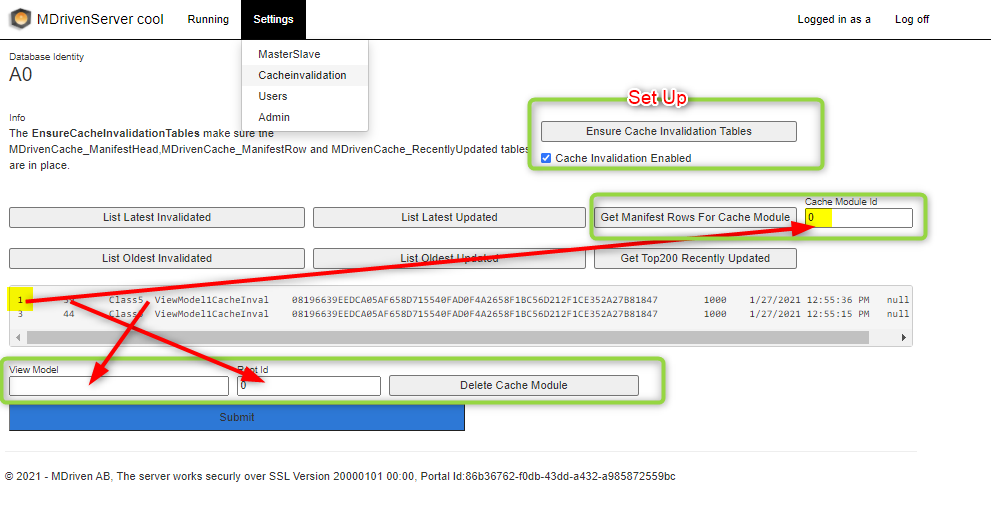Read the background: https://blog.mdriven.net/cache-invalidation-a-real-problem-for-us-all/
Update 2022-11-29 - to clear cache invalidation data and start over
To clear every cache module you need to delete in the database accordingly:
delete from MDrivenCache_ManifestHead delete from MDrivenCache_ManifestRow
Deleting the heads will make objects of relevant classes re-create the cache modules still marked for cache invalidation
Admin and Update - Update 2021 January
CacheInvalidation maintaince view in MDrivenServer:
In this UI you can find out the Latest or oldest Invalidated, and updated cache modules. You can list all the manifest rows for one module. You can delete a module if needed.
Update to strategy 20200312
Changes to cache invalidation. Save writes to recentlyupdatedtable, and then this table was joined with cache manifest that could take time - and this locked the recentlyupdatedtable table that in turn limited other saves for the complete system.
To fix this a new table has been added recentlyupdatedtableWorkPart. We quickly move seen rows in recentlyupdatedtable to recentlyupdatedtableWorkPart to minimize the time recentlyupdatedtable is in a transaction. Then we do the potential heavy work from the recentlyupdatedtableWorkPart table.
The EnsureCacheInvalidationTables functions adds the recentlyupdatedtableWorkPart table even if it is the only one missing.
Orginal strategy
MDrivenCacheInvalidationAdmin
- LastInvallidationLoop
- LastUpdateLoop
MDrivenCacheInvalidationRecentlyUpdated
- id
- classname
- membername
- time
MDrivenCacheManifestHead
- ViewModel
- RootId
- Class
- viewmodelMetaChecksum // set on update
- priority // set by viewmodel property - this way information can control importance!
- Updated // set on update
- Invalidated
MDrivenCacheManifestRow
- Id
- Class
- MemberName
Upon normal save
new rows indicating member level change are inserted in MDrivenCacheInvalidationRecentlyUpdated
Special treatment of newly created and deleted objects - they get the **created and **deleted flag
For changed embedded links (single end) we also add dirty of other end
Upon InvalidationLoop
we look for direct hits on id and attribute and invalidate
we look for any objects of class that has been changed recently that now should be part of the set
(ie other end of OptionalAssociationEndNameForBeingIncluded , does it point to id -> invalidate)
we look for manifest rows indicating use of allinstances and match to **created and **deleted and invalidate
we look for meta checksum change of viewmodel
Upon UpdateLoop
We look for Invalidated that has the diff between Now and Invalidated higher than allow oldness, we sort these by priority.
For each cache found we instansiate the named ViewModel with for the given root object.
We execute all actions on the ViewModel
We save all the used and hence dependant model usage during cache - allowing us to set persisted calculated fields and create persisted derived objects.
We ignore use of common super class members to avoid having caches be invalidate by un-precise things ie changetime
Things to think about
How do we ensure initial creating of cache - when a new cache is created that already have existing root objects?
Is the current polled criteria based SSVM-Run helpful? Is it the criteria based expression that discovers new cache needs or is it based on type alone? ! Type alone - criteria will be hidden in UI and ignored in RT
Is the cache type-wise complete - or only on matching the polling criteria? ! Type complete - all objects for type will get a cache manifest
If we want to involve the polling criteria (ocl-ps) with creation need - do we also want it with refresh need? ! No
- If we involve the polling criteria in refresh decision we may end up with a invalidated caches that never gets updated and that is not good.
- It may be easier for user to completely separate the polled criteria ViewModels from the auto invalidated, mixing the two reasons for running may get confusing
- We still want the polling periodicity for update discovery to be controllable by user and also the chunking ! Yes - chunking and periodicity still applies
Anyway we look at it - we need someway to join in the cachehead to make use of the invalidated value in order to select viewmodels to create/refresh
select d.a0_detailid from a0_detail d where CAST(d.a0_detailid AS nvarchar(30)) not in (select rootid from a0_mdrivencache_manifesthead where viewmodel='ViewModelServerSideDetail')
This limits the possible RootObjects in cached viewmodels to having a single key column.
The discover of missed cached roots only creates invalidated heads - then the update process discovers, orders and executes updates.
Special ViewModel considerations
The ViewModel used in cache has the option to use the following attributes with special meaning:
CacheIgnoreClasses - set of strings that corresponds to name of classes to ignore in manifest and hence in invalidation. Example: Set{User.asstring,Singleton.asstring,SysSingleton.asstring,AcoSuper.asstring}
Priority - integer written to head and used with order by by next update loop 1 is higher priority than 1000 (default on update is 1000, on new cacheneed found prioritu is 1)
Practical queries
What has changed but not yet made it to check if it will invalidate anything
select count(*) from MDrivenCache_RecentlyUpdated
Same as above grouped on class and member:
select count(*),classname,membername from MDrivenCache_RecentlyUpdated group by classname,membername order by classname,membername

